| Back Number | No.08 2005/02/02 | |||
| News | EXPO Eco Tours & EXPO Eco-Money |  |
||
| Pavilions : MITSUI-TOSHIBA Pavilion | ||||
| Interview | Ferdinand Nagy (Romania) Romanian Commissioner General of EXPO 2005 Aichi, Japan |
|||
| Column | Sightseeing Spots in the Vicinity of the EXPO 2005 Aichi, Japan Venue | |||
![]()
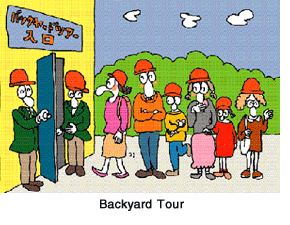 During EXPO 2005 Aichi, Japan, the Japan Association for the 2005 World Exposition will be conducting EXPO Eco Tours in which participants will visit environmentally-friendly facilities, observe new energy systems, etc.
During EXPO 2005 Aichi, Japan, the Japan Association for the 2005 World Exposition will be conducting EXPO Eco Tours in which participants will visit environmentally-friendly facilities, observe new energy systems, etc.In the Backyard Tour, co-hosted with the industry association Environmental Partnership Organizing Club (EPOC), participants will be able to see the advanced environmental technologies supporting the venue that are hidden from view to the general public. There will be two tour routes. The Energy Course (North course) will tour such facilities as the hydrogen station as well as the GAS PAVILION, while the Recycling Systems Course (South course) will visit new energy facilities, such as those for fuel cell power generation, as well as Japan Pavilion Nagakute, etc. Each tour is 2 hours long, and tours will be held two times a day. The maximum capacity will be 30 people per course. The tour will be conducted for the benefit of EXPO 2005 visitors with an interest in environmental technologies. The Backyard Tour is scheduled to be held every Friday beginning April 15. Advance reservations are necessary for participation. A total of roughly 3,000 people are expected to participate during the duration of the EXPO. A portable English audio guidance system will be available for non-Japanese participants. However, if they are participating as a group, they will need to have a translator with them. |
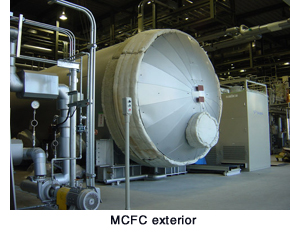 The Kids Eco Tour will be co-hosted with the EXPO 2005 Volunteer Center. About 10 locations within the Nagakute Area will be explained in this tour, including solar panels, the new energy power generation system utilizing kitchen refuse and the Bio-lung. The tour will take about 1 hour. There will be “eco guide” on hand to lead a group of 10 children each. Intended for upper elementary school grade to junior high school students, the Kids Eco Tour will be conducted everyday (40 tours per day) from April 22 to September 25. A total of 50,000 children are expected to participate in this tour.
The Kids Eco Tour will be co-hosted with the EXPO 2005 Volunteer Center. About 10 locations within the Nagakute Area will be explained in this tour, including solar panels, the new energy power generation system utilizing kitchen refuse and the Bio-lung. The tour will take about 1 hour. There will be “eco guide” on hand to lead a group of 10 children each. Intended for upper elementary school grade to junior high school students, the Kids Eco Tour will be conducted everyday (40 tours per day) from April 22 to September 25. A total of 50,000 children are expected to participate in this tour.Furthermore, a Self Eco Tour will be co-hosted with the Ministry of the Environment. This is an unaccompanied tour in which each visitor will use an “Eco Map” (tentative name) to guide themselves freely around various facilities, etc. The map is scheduled to be distributed at the Information Center, etc. A total of about 50 environmentally-friendly facilities, in both the Nagakute and Seto areas, will be introduced on the map. A total of roughly 500,000 people are expected to participate in this tour. Look here for further information about the EXPO Eco Tour. |
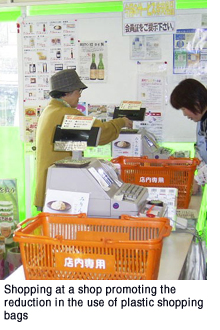 EXPO Eco-Money consists of points that will be issued as part of the EXPO Eco-Money Project, which is a project with the objectives of reducing the emission of carbon dioxide, one of the causes of global warming, and protecting the Earth’s environment. This experimental project for a new social system will promote the environmentally-friendly activities of citizens, such as the reduction in the use of plastic shopping bags and the proactive use of public transportation. Experiment and verification of Eco-Money is scheduled to be conducted within the EXPO venue during EXPO 2005 in conjunction with similar trials taking place outside the venue. The system for registering points on the IC chip embedded in the EXPO admission ticket will be utilized.
EXPO Eco-Money consists of points that will be issued as part of the EXPO Eco-Money Project, which is a project with the objectives of reducing the emission of carbon dioxide, one of the causes of global warming, and protecting the Earth’s environment. This experimental project for a new social system will promote the environmentally-friendly activities of citizens, such as the reduction in the use of plastic shopping bags and the proactive use of public transportation. Experiment and verification of Eco-Money is scheduled to be conducted within the EXPO venue during EXPO 2005 in conjunction with similar trials taking place outside the venue. The system for registering points on the IC chip embedded in the EXPO admission ticket will be utilized.Within the EXPO venue, visitors will be awarded Eco-Money points through such eco-friendly actions as participating in environmental learning and enlightenment programs, such as the EXPO Eco Tour and the nature experience programs “Forest Nature School and Village Nature School”, as well as for cooperating in the reduction in the amount of plastic shopping bags used when purchasing items at the shops of official participant countries, etc., for purchasing eco-friendly products, or for coming to EXPO 2005 in an eco-car. Outside the EXPO venue, the project will be widely advanced through collaboration with companies that promote the reduction of plastic shopping bags used, and others. Through a lottery method, individuals will be able to use the accumulated points for a chance to win complimentary tickets for eco-tours to places that are richly endowed with nature, etc., while the points will also be passed on for the good of society through exchange into donations to be made towards reforestation projects. The impact of the overall project is scheduled to be published on a website in quantitative terms, such as the amount of CO2 emissions reduced. It has been determined that the EXPO Eco-Money activities will be continued even beyond the duration of EXPO 2005 after being handed off to the Eco-Design Civil Society Forum, an NPO based in Nagoya City. The aim is to have this project develop on a broad-basis with EXPO 2005 as the trigger. The Japan Association for the 2005 World Exposition would like to promote citizen-led eco-movements through the EXPO Eco-Money Project, while also collaborating with citizen’s movements that aim to reduce global warming or create a recyling-oriented society. |
![]()
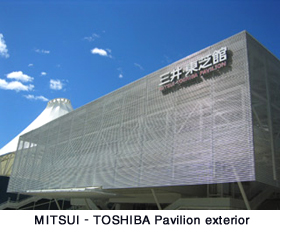 When you step into the Corporate Pavilion Zone in the Nagakute Area of EXPO 2005 Aichi, Japan, you will see a building covered with a wall off running water that is giving forth a sense of coolness. This is the MITSUI-TOSHIBA Pavilion. Under the concept “the feeling Earth,” this structure is an expression of the vibrancy created by life on our planet Earth.
When you step into the Corporate Pavilion Zone in the Nagakute Area of EXPO 2005 Aichi, Japan, you will see a building covered with a wall off running water that is giving forth a sense of coolness. This is the MITSUI-TOSHIBA Pavilion. Under the concept “the feeling Earth,” this structure is an expression of the vibrancy created by life on our planet Earth. |
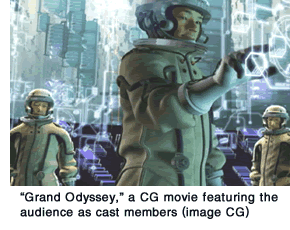 The theme of the MITSUI-TOSHIBA Pavilion is “Illuminating life on Earth - Passing a new Earth onto the next generation.” It will pass onto children, who are our future, the importance of protecting our irreplaceable Earth and living in harmony with nature.
The theme of the MITSUI-TOSHIBA Pavilion is “Illuminating life on Earth - Passing a new Earth onto the next generation.” It will pass onto children, who are our future, the importance of protecting our irreplaceable Earth and living in harmony with nature.The main show, to be shown at the theater on the second floor, is the world’s first 3D CG movie in which the audience will appear on screen as part of the cast. Entitled, “Space Child Adventure: Grand Odyssey,” it tells the story of humankind of the distant future who have evacuated to outer space after the Earth’s ecosystem was destroyed, and their journey to return to Mother Earth. |
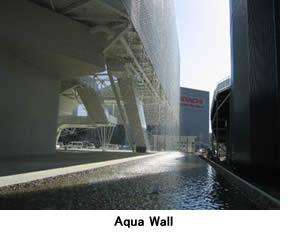 The system being used for this movie is Futurecast, the first such entertainment system in the world. Upon entrance, the audience uses a 3D scanner to have information from their faces captured. The captured information is then instantly rendered into computer graphics and transferred to the movie so that the face of the audience member will appear as one of the movie’s characters. This innovative system enables the audience to become one of the characters of this story. The gender of the person whose face is scanned is judged by the face, and the system can allocate different roles accordingly. All 240 people, the theater’s capacity, will appear in one of the movie’s scenes and will play opposite to Yuzo Kayama, a famous Japanese actor who will be playing the role of the captain of the spaceship, and other actors. The movie is about 14 minutes long.
The system being used for this movie is Futurecast, the first such entertainment system in the world. Upon entrance, the audience uses a 3D scanner to have information from their faces captured. The captured information is then instantly rendered into computer graphics and transferred to the movie so that the face of the audience member will appear as one of the movie’s characters. This innovative system enables the audience to become one of the characters of this story. The gender of the person whose face is scanned is judged by the face, and the system can allocate different roles accordingly. All 240 people, the theater’s capacity, will appear in one of the movie’s scenes and will play opposite to Yuzo Kayama, a famous Japanese actor who will be playing the role of the captain of the spaceship, and other actors. The movie is about 14 minutes long.The exterior walls of this pavilion are covered by the Aqua Wall. Tube and coupler scaffolding used at construction sites have been laid parallel to each other, down which water falls. 20 liters of water will be released per minute from the roof and the water will flow down from tube to tube creating a streaming wall of water. The latent heat of evaporation will lower the temperature of the pavilion’s corridors. A cooling breeze will also flow into the pavilion interior allowing the range of air conditioning to be limited to the pavilion’s theater area. The Aqua Wall will help to minimize the use of electricity for cooling purposes in the interiors of the pavilion. The water, which is accumulated at a pond that surrounds the pavilion, is pumped back up to the roof and reused. The tube and coupler scaffolding is planned to be reused upon the conclusion of EXPO 2005 at another construction site. Many other efforts have also been made in the construction of this pavilion to minimize waste at the end of EXPO 2005, including the employment of reusable steel and leased materials. Why not enjoy an amazing video experience at the MITSUI-TOSHIBA Pavilion in which you will be able to appear on the big screen as a cast member. |
![]()
![]()
 |
|
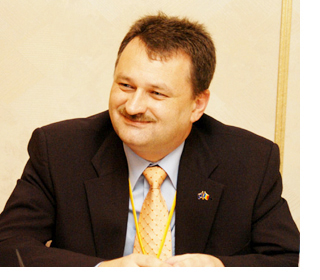 Romania is developing its pavilion based on the concept of “a heritage for the future.” We will present live performances, craft demonstrations and films as introductions of our way of life and cultural heritage. Also, because five percent of Romanian territory is designated as protected areas, we think that it is very important to present our beautiful landscape, nature and environmental conservation measures to the people of other countries. This is why the general concept of the Romanian pavilion is focusing on Romania’s 21st century perspective on nature, and tradition as being the roots of our European cultural richness.
Romania is developing its pavilion based on the concept of “a heritage for the future.” We will present live performances, craft demonstrations and films as introductions of our way of life and cultural heritage. Also, because five percent of Romanian territory is designated as protected areas, we think that it is very important to present our beautiful landscape, nature and environmental conservation measures to the people of other countries. This is why the general concept of the Romanian pavilion is focusing on Romania’s 21st century perspective on nature, and tradition as being the roots of our European cultural richness.While Japan is a developed industrial country, I am well aware of the care that Japan takes of its nature. I think that there is great significance in appealing the importance of protecting our environment through EXPO 2005 Aichi, Japan, a major event of the new century. “Nature’s Wisdom,” the main theme of EXPO 2005, when interpreted from a different perspective can be said to be “Humankind’s Wisdom,” meaning the human wisdom to protect the environment and nature, to preserve forests and clean water. In that perspective, the Romanian pavilion will offer to visitors an integrated, all day show - including a video presentation (on a 12 m. wide screen) of nature, traditions, history and our environment-friendly technologies as well as live artistic performances and demonstrations of traditional craftsmanship. The visitor will be introduced to Romania in the atmosphere of a riverside community, the new and old being put together in an amazing experience of lights, sounds and images; a sampling of the Romanian “Art of Life.” I would also like to draw attention to the wonderful organizational strength of Japan that is coordinating such a big event so smoothly. The exhibitors and organizer are maintaining a close relationship. We are already friends, and in a way, we are part of a big family. It is of great significance that people with different cultural backgrounds and ways of thinking come together at EXPO 2005 to find common solutions for their common problems. I strongly believe that Romanian presence will build a bridge between the people of Romania and the people of Japan. |
|
![]()
|
There are many attractive sightseeing destinations in the area surrounding the EXPO 2005 Aichi, Japan venue. Let’s take a look at some of them in Aichi Prefecture, where EXPO 2005 will be held, as well as in neighboring prefectures Gifu, Mie and Shizuoka. |
|
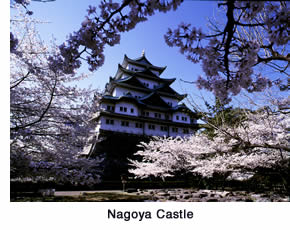 <Aichi Prefecture>
<Aichi Prefecture>Aichi Prefecture developed from ancient times as a crossroads between the cultures of eastern and western Japan. During the Edo period (1603-1867), it prospered as an area containing one of Japan’s leading castle towns. Many historical assets can be found in the prefecture. For example, there is Nagoya Castle, built by order of Tokugawa Ieyasu who founded the Edo Shogunate that governed Japan for well over 200 years. The pair of dolphin-like fish that adorns the roof of the castle tower - called Shachihoko - has the head of a tiger and the body of a fish. They are the symbol of Nagoya City. The Shachihoko will be brought down from the donjon during EXPO 2005 Aichi, Japan for exhibition at the castle. Meanwhile, the Tokugawa Art Museum has a collection of 20,000 so-called Daimyo Dohgu, or the treasures and implements of the daimyo, which allow visitors to see the lifestyle and culture of the feudal lords of the Edo period. Other important items possessed by this museum include extant sections of the Illustrated Handscroll of the Tale of Genji. It depicts the life of the Japanese aristocracy during the 11th century. Designated a Japanese national treasure, this picture scroll is based on the “Tale of Genji,” which is recognized as being one of the world’s best literary works. The Museum Meiji-mura (Meiji Village) is an open-air museum that preserves and collects cultural relics from the Meiji period (1868-1912), with a special focus on architecture. Steam locomotives and streetcars that retain their original appearance run within this village that contains a diverse range of Meiji-period buildings, from churches to a post office and even a Japanese theater. Many memorial museums related to various industries can also be found in Aichi Prefecture, including the Toyota Commemorative Museum of Industry and Technology that exhibits the history, etc. of automatic looms, spinning machinery, and automobile production. It should also be enjoyable to visit other industrial sightseeing facilities and experience traditional Japanese handicraft techniques, such as pottery or Japanese paper making. |
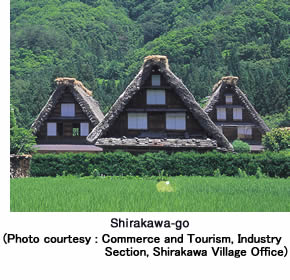 <Gifu Prefecture>
<Gifu Prefecture>The Hida area, located in northern Gifu Prefecture, is surrounded by majestic mountains. Here, visitors will find Shirakawa-go with its village of Gassho-style farmhouses that were designated a UNESCO World Heritage cultural site in 1995 as a group of precious buildings. In this remote village, deep in the mountains, there are 113 farmhouses with steeply-pitched thatched roofs that look like hands brought together in prayer. The Gassho-style was developed to create long-lasting roofs that will withstand the weight of the area’s heavy snowfall. The farmhouses have also basically been erected in regularly established directions in order to minimize the effects of strong northerly winds. Shirakawa-go is an area where people still live their daily lives. The spirit of “yui,” or labor sharing, is retained and enables the region to pass its accumulated wisdom and culture on to the future. Meanwhile, Takayama, an area that prospered as a castle town, is known today as a “Little Kyoto.” Here, visitors will find preserved beautiful streets as well as buildings constructed during the Edo period by the master carpenters of Hida. A stroll through the streets that still retain the flavor of the Edo period will allow visitors to feel the slow passage of time. Shopping at the morning market filled with rows of fresh vegetables, fruits and flowers is also an enjoyable experience. The Takayama Festival, held here in spring and autumn, is considered one of the three most beautiful festivals of Japan. |
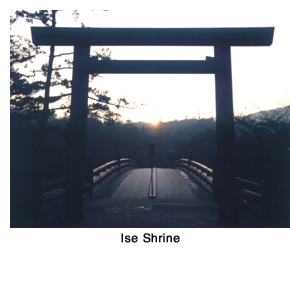 <Mie Prefecture>
<Mie Prefecture>Mie has a long coastline that faces Ise Bay, with its calm waves, and the Kumano-nada Sea which is washed by the Kuroshio (Japan) Current. Ise Shrine, which has held a special position in Japan’s Shinto faith since ancient times, is located in Mie Prefecture. Between the medieval and modern ages, Ise Shrine was the center of the faith of a great many of the general public. So many people visited this shrine that it became a generally accepted notion that a person should visit Ise Shrine at least once in their lifetime. Kumano Kodo - Iseji, which is included in “The Sacred Sites and Pilgrimage Routes in the Kii Mountain Range” inscribed on the World Heritage List in 2004, is a pilgrimage route that has linked Ise Shrine with the Kumano Sanzan (the collective name for the three main shrines of the Kumano area in Wakayama Prefecture: Kumano Hongu Taisha, Kumano Hayatama Taisha and Kumano Nachi Taisha) since olden times. After following the route across many mountain passes, a magnificent view of the mighty ocean will suddenly spread before your eyes. It is a moss-covered stone-paved route that follows Mie Prefecture’s long coastline. |
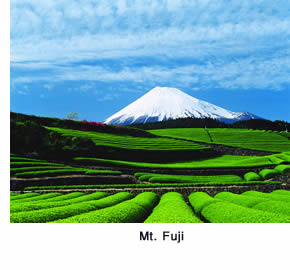 <Shizuoka Prefecture>
<Shizuoka Prefecture>Shizuoka is a prefecture that is blessed with a mild climate and an abundance of sea and mountain delicacies. The famous Atami and Ito hot spring resorts that are representative spas in Japan are located in Shizuoka Prefecture. Mt. Fuji, the mountain that shows a different expression depending on the season or where you are looking at it from and has captured the hearts of the Japanese people is also a sightseeing spot situated in Shizuoka. A climb up Mt. Fuji is something visitors may want to challenge. The scenic Lake Hamana, in the western extremity of the prefecture, and its vicinity are a resort area that visitors can enjoy in a variety of ways, including partaking in marine sports activities, hiking and visiting old, distinguished temples. |
|
Visitors to EXPO 2005 can go on a daytrip to an interesting sightseeing spot, or spend around two nights and three days touring a prefecture that they like. We hope that visitors will be able to enjoy the various charms that Japan has to offer. |
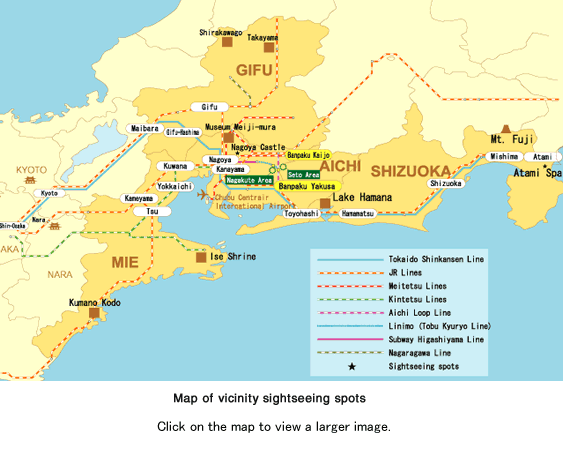
|
| EXPO 2005 AICHI, JAPAN Newsletter | |
| To read past issues:Back Number | |
| Editor/Publisher: Japan Association for
the 2005 World Exposition Head Office: 1533-1 Ibaragabasama, Nagakute-cho Aichi 480-1101 Japan Nagoya Office: Nagoya Daiya II Bldg 4F, 3-15-1 Meieki Nakamura-ku, Nagoya, Aichi 450-0002 Japan Tokyo Office: Iino Bldg 8F, 2-1-1 Uchisaiwai-cho Chiyoda-ku, Tokyo 100-0011 Japan |
 |
© Japan Association for the 2005 World Exposition
